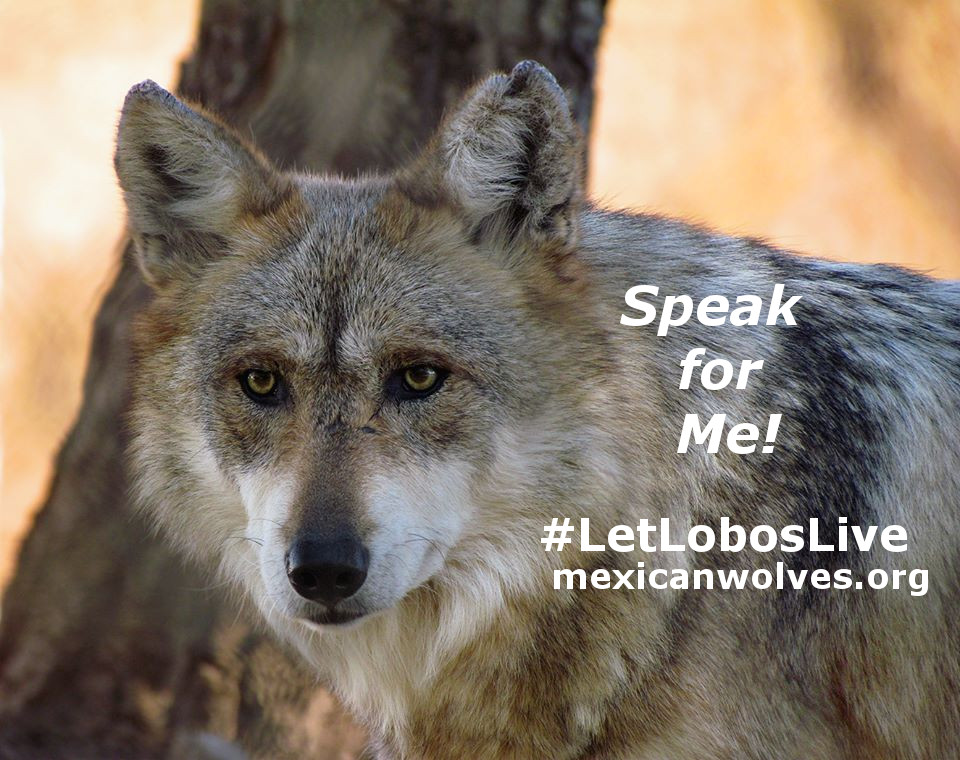24
Jul
In the News: Mexican wolf advocates make final push against recovery plan

It was 95 degrees in Albuquerque on Saturday afternoon as a wolf enthusiast dressed in a thick, faux fur costume waved to drivers from the corner of University Boulevard, holding a sign that read, “Strong Protections for Endangered Wolves.” Some cars honked in support as they passed.
The wolf mascot was one of about 30 protesters who flanked the sidewalk outside the Crowne Plaza hotel, advocating for endangered Mexican gray wolves. They had gathered ahead of a public meeting about a new federal management plan for the animals, developed by the U.S Fish and Wildlife Service. It was the last of four meetings in New Mexico and Arizona to gather public input on the plan, which many conservationists oppose. They say it won’t ensure the species’ survival.
“There are more people in this parking lot than there are Mexican gray wolves in New Mexico,” said Michael Robinson, a wolf advocate with the Center for Biological Diversity. “We need to keep the land alive. We need to keep nature alive.”
The group howled in unison.
Inside, the crowd of about 80 people was dominated by wolf advocates wearing lime-green T-shirts saying, “wolves without boundaries.” They harshly criticized federal officials for a draft plan they said would unreasonably limit the territory for wolf recovery and set an unprecedented cap on how many endangered animals could roam and reproduce in the wild.
Wolf advocates also criticized the federal agency’s decision to join with Mexico in the wolf recovery effort rather than allowing the wolves to roam into other areas of the U.S., like the Grand Canyon. And they said the plan would cede too much control to the states.
Punctuating those concerns, a critic of the plan told The New Mexican that his group will submit comments opposing the plan because it wants to halt altogether the releases of captive-born wolves into the wild population — a key part of the federal recovery effort.
“In a nutshell, we are opposed to the release of Mexican wolves in the state,” said Tanner Anderson, the southeast regional director for the New Mexico Farm and Livestock Bureau. “We already deal with a lot of predation from coyotes, bears, you name it.”
It has been been more than three decades since the federal agency updated its guidelines for how to rebuild the population of the Mexican wolf in the Southwestern U.S., a species that was hunted to near extinction in the early 1900s.
When wolf reintroduction began in Arizona in 1998, there were no Mexican wolves in the wild in the U.S. Now there are 113 roaming in Southern New Mexico and Arizona.
But the recovery program has faced pushback from the two states, and from ranchers who say the animals slaughter their cattle and slash their profits.
New Mexico officials have taken legal action seeking to block wolf releases in recent years. Without an updated management plan, the state has argued, there was insufficient science to justify placing more wolves in the wild. A federal court ordered Fish and Wildlife to finalize a new management plan for the wolves by November.
The draft plan, released at the end of June, will be open for public comment until Aug. 29.
The plan calls for revitalizing the Mexican wolf population by increasing the population and its genetic diversity across New Mexico and Arizona, south of Interstate 40. It says the species will be considered fully recovered when there are 320 wolves in the wild for at least eight years and after 22 captive wolves have been released in the wild and survive beyond the age of 2, which is when wolves begin breeding.
The agency said it can begin to remove protections for the species after those numbers are reached and hold steady over a four-year period. Full species recovery based on these guidelines could take up to 35 years, officials said, but progress will be reassessed again in five years.
If the population exceeds 380 wolves, the plan says, wolves can be relocated to Mexico or removed from the wild in the U.S. by other means.
“Having a cap is highly unusual,” said Michael Dax, with Defenders of Wildlife.
While the wild wolf population has grown in the past two decades, it has faced repeated problems, including poaching. During Saturday’s meeting, federal officials said just 28 percent of wolves released in the wild survive beyond the first year — mostly because of hunting and car collisions.
Federal officials said the plan is aimed at promoting interagency collaboration, largely between Mexico and the U.S., but also with tribal entities, the Forest Service and Arizona.
New Mexico is not part of that effort. The state withdrew from a partnership with the wolf recovery program in 2011 when Gov. Susana Martinez took office.
In November 2015, Martinez, along with Arizona Gov. Doug Ducey, Colorado Gov. John Hickenlooper and Utah Gov. Gary Herbert wrote to then-Interior Secretary Sally Jewell, saying they had serious concerns about the wolf management program. While they support species recovery, the letter said, “we do not support recovery of the Mexican wolf across regions and landscapes that are not part of the subspecies’ historical range.”
The letter goes on to say that 90 percent of the animal’s historic range is in Mexico.
Mexico currently has 28 Mexican gray wolves and a goal of reaching 150. But maps and wildlife plans indicate areas for viable populations there are limited, and the recovery effort in that country relies on partnerships with private landowners.
In 2016, after the Fish and Wildlife Service release two newborn wolf pups into the Gila Wilderness without a state permit, New Mexico sued the federal government. But a court ultimately denied the injunction, and the federal agency released more pups this spring. The lawsuit is still pending.
Dan Ruppert, 57, of Albuquerque asked federal officials how the plan would boost the wild wolf numbers “if state action is interfering with sustainable numbers in the first place. “¦ Can state action be overwritten?”
Sherry Barrett, coordinator of the Mexican Wolf Recovery Program for the Fish and Wildlife Service in Albuquerque, said she didn’t have an answer.
It was a fear repeated by many others at the meeting. Several people said the new plan appears to give states more power, even though the New Mexico Department of Game and Fish and the New Mexico Game Commission having a history of opposing wolf releases.
“I simply don’t have any confidence at all that they can be a steward of the Mexican wolf,” said Brenda McKenna of Albuquerque, a member of Nambé Pueblo.
The draft wolf management plan had at least one fan in crowd.
Paul Kienzle, chairman of the New Mexico Game Commission, who said he was attending the meeting as a private citizen, said, “I think the plan is a great step forward.”
This article was published in the Santa Fe New Mexican.
~~~~~~~~~~~~~~~~
Show your support for Mexican wolves with a Letter to the Editor today!
The letters to the editor page is one of the most widely read, influential parts of the newspaper. One letter from you can reach thousands of people and will also likely be read by decision-makers. Tips for writing your letter are below, but please write in your own words, from your own experience. Don’t try to include all the talking points in your letter.
Letter Writing Tips & Talking Points
“¢ The U.S. Fish and Wildlife Service is required, by law, to incorporate the best available science into its Mexican gray wolf recovery plan. Unfortunately, they have scrapped this duty in order to attain the best political deal they could find. They have chosen to make hostile state agencies happy rather than uphold their duty to consider the best available science. The previous recovery planning science team clearly identified what these wolves need, yet those findings are being ignored.
“¢ The U.S. Fish and Wildlife Service wants to hand the management of the Mexican gray wolf recovery program to the states who have done everything in their power to sabotage the species’ recovery. Arizona game and fish ran the program for six years previously, and in that time they managed to reduce the number of wolves in the wild. The serious genetic problems the wild population is in is a direct result of the mismanagement by Arizona. If this plan is not dramatically changed, it will very likely drive the lobo to extinction.
“¢ The Mexican gray wolf draft recovery plan includes reckless delisting criteria for the critically endangered wolf. The plan allows for delisting the wolf after twenty-two wolves released from captivity reach reproductive age. But just reaching reproductive age does not ensure their genes will be contributed to the wild population. We have seen that poaching is a major threat to individual wild wolves and if these wolves are killed before they breed, the species will still be removed from the endangered species list.
“¢ Mexican gray wolves will need connectivity between wild populations in order to recover. Connectivity would be easy were they allowed to establish in the two additional suitable habitats in the U.S., the Grand Canyon area and the Southern Rockies. Instead, the U.S. Fish and Wildlife Service is proposing to restrict the wolves to south of Interstate 40 and to establish a second population in Mexico. There is a barrier along large sections of the international border, talk of extending that barrier to an impenetrable wall, and the last wolf who crossed that border was removed from the wild.
“¢ The federal agency charged with recovery of the critically endangered Mexican gray wolf has decided to put the onus of recovery on Mexico, despite the fact that this could wipe the species out. Mexico does not have nearly as much public land for the wolf, they have very little enforcement to deal with poaching, and as species shift north in response to climate change Mexican habitat will become even less suitable for wolves.
Make sure you:
“¢ Thank the paper for publishing the article
“¢ Submit your letter as soon as possible. The chance of your letter being published declines after a day or two since the article was published
“¢ Do not repeat any negative messages from the article, such as “so and so said that wolves kill too many cows, but”¦” Remember that those reading your letter will not be looking at the article it responds to, so this is an opportunity to get out positive messages about wolf recovery rather than to argue with the original article
“¢ Keep your letter brief, under 350 words
“¢ Include something about who you are and why you care: E.g. “I am a mother, outdoors person, teacher, business owner, scientific, religious, etc.”
“¢ Provide your name, address, phone number, and address. The paper won’t publish these, but they want to know you are who you say you are.
Submit your letter to the editor of the The Santa Fe New Mexican.
~~~~~~~~~~~~~~~~~~~~~~~~~~~~~~~~~~~~~~~~
DO EVEN MORE FOR LOBOS!
~~~~~~~~~~~~~~~~~~~~~~~~~~~~~~~~~~~~~~~~
Submit comments to the Fish and Wildlife Service before August 29
Talking Points are Provided HERE.
Talking Points are Provided HERE.
Electronically: Go to www.regulations.gov and enter FWS—R2—ES—2017—0036
Hard copy: Submit by U.S. mail or hand-delivery to:
Public Comments Processing
Attn: FWS-R2-ES-2017-0036
U.S. Fish and Wildlife Service, MS: BPHC
5275 Leesburg Pike
Falls Church, VA 22041-3803
Public Comments Processing
Attn: FWS-R2-ES-2017-0036
U.S. Fish and Wildlife Service, MS: BPHC
5275 Leesburg Pike
Falls Church, VA 22041-3803
Additional Documentation Referenced in Draft Plan:
Draft Biological Report for the Mexican Wolf, May 1, 2017 version
Mexican Wolf Habitat Suitability Analysis in Historical Range in Southwestern US and Mexico, April 2017 version




